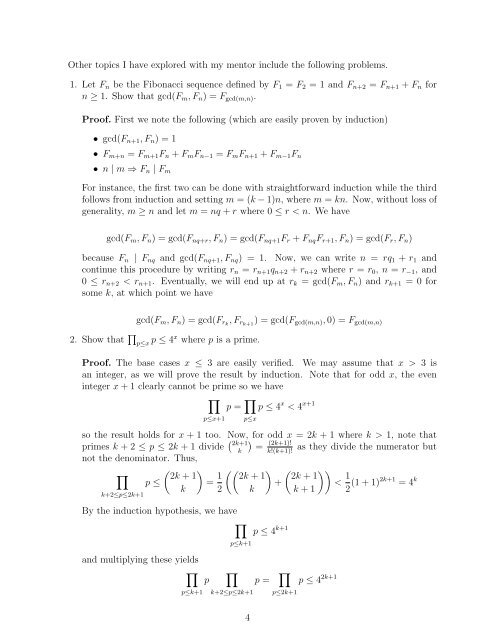Discrete Geometry and Extremal Graph Theory - IMSA
Discrete Geometry and Extremal Graph Theory - IMSA
Discrete Geometry and Extremal Graph Theory - IMSA
Create successful ePaper yourself
Turn your PDF publications into a flip-book with our unique Google optimized e-Paper software.
Other topics I have explored with my mentor include the following problems.<br />
1. Let F n be the Fibonacci sequence defined by F 1 = F 2 = 1 <strong>and</strong> F n+2 = F n+1 + F n for<br />
n ≥ 1. Show that gcd(F m , F n ) = F gcd(m,n) .<br />
Proof. First we note the following (which are easily proven by induction)<br />
• gcd(F n+1 , F n ) = 1<br />
• F m+n = F m+1 F n + F m F n−1 = F m F n+1 + F m−1 F n<br />
• n | m ⇒ F n | F m<br />
For instance, the first two can be done with straightforward induction while the third<br />
follows from induction <strong>and</strong> setting m = (k − 1)n, where m = kn. Now, without loss of<br />
generality, m ≥ n <strong>and</strong> let m = nq + r where 0 ≤ r < n. We have<br />
gcd(F m , F n ) = gcd(F nq+r , F n ) = gcd(F nq+1 F r + F nq F r+1 , F n ) = gcd(F r , F n )<br />
because F n | F nq <strong>and</strong> gcd(F nq+1 , F nq ) = 1. Now, we can write n = rq 1 + r 1 <strong>and</strong><br />
continue this procedure by writing r n = r n+1 q n+2 + r n+2 where r = r 0 , n = r −1 , <strong>and</strong><br />
0 ≤ r n+2 < r n+1 . Eventually, we will end up at r k = gcd(F m , F n ) <strong>and</strong> r k+1 = 0 for<br />
some k, at which point we have<br />
gcd(F m , F n ) = gcd(F rk , F rk+1 ) = gcd(F gcd(m,n) , 0) = F gcd(m,n)<br />
2. Show that ∏ p≤x p ≤ 4x where p is a prime.<br />
Proof. The base cases x ≤ 3 are easily verified. We may assume that x > 3 is<br />
an integer, as we will prove the result by induction. Note that for odd x, the even<br />
integer x + 1 clearly cannot be prime so we have<br />
∏<br />
p ≤ 4 x < 4 x+1<br />
p≤x+1<br />
p = ∏ p≤x<br />
so the result holds for x + 1 too. Now, for odd x = 2k + 1 where k > 1, note that<br />
primes k + 2 ≤ p ≤ 2k + 1 divide ( )<br />
2k+1<br />
k =<br />
(2k+1)!<br />
as they divide the numerator but<br />
k!(k+1)!<br />
not the denominator. Thus,<br />
∏<br />
( ) 2k + 1<br />
p ≤ = 1 (( ) ( ))<br />
2k + 1 2k + 1<br />
+<br />
< 1 k 2 k k + 1 2 (1 + 1)2k+1 = 4 k<br />
k+2≤p≤2k+1<br />
By the induction hypothesis, we have<br />
∏<br />
<strong>and</strong> multiplying these yields<br />
∏<br />
p≤k+1<br />
p<br />
p≤k+1<br />
∏<br />
k+2≤p≤2k+1<br />
p ≤ 4 k+1<br />
p =<br />
∏<br />
p≤2k+1<br />
p ≤ 4 2k+1<br />
4
















